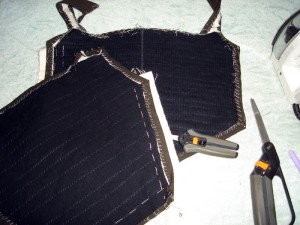When I last posted about this project the skirts were done save for the hem.
So it is time to move on to the bodice!
When I cut the bodice out I had no lining or interlining with me, it was all at home. Then once I got home my sewing plans were put on hold due to an accident with a bench grinder and my thumb.
It was a small hurt but it put a stop to any hand sewing, and made the project take a bit longer then it should have.
For the bodice used my mock-up pattern for the Pisa gown, which in turn was based off my block pattern that I use for almost everything. I had high hopes for it, and decided while I could not hand sew I would indulge in some machine sewing where it would never show.
I cut out a layer of heavy twill for interlining and a layer of muslin and then zig zag stitched the two together, in period this layer might have been pad stitched. But the machine zig-zag does the job pretty well.

I then set the project aside.
Once my thumb had healed I set about re-ironing the pieces and then basted the muslin to the wool. I then turned the wool edges over and stitched them down to the interlining with the whip stitch. This goes pretty fast as you don’t have to use tiny fine stitches. After all what if you have to unpick something to fix it?
Then I cut out some fine black linen I had been saving and slip stitched it in by hand with silk thread.
I went all around the top, the straps and the side edges. I left the bottom of the bodice open because I had yet to attach the skirts and wasn’t sure how I was going to go about it. Since I was not lining the skirts I didn’t want to do the usual fold the edge over or face it and whip stitch into place. It seemed like that would give me unnecessary bulk that would show through.

So instead I carefully hand basted the skirt in place just to the wool and interlining, cutting the V for where the bodice met the top, which in retrospect might not have been needed. I then back-stitch the skirt to the bodice by hand along the edge. There is a note in Patterns of Fashion where Janet Arnold speculates the skirt of Elenora di Toledo’s gown might have had the skirt top stitched to it. I did the same to the back of the skirt after knife pleating it.
I sewed the linen lining down next and then started on the eyelets.